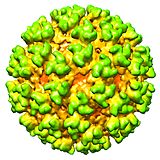Portal:Viruses/Selected virus/13
Alphaviruses are a genus of RNA viruses in the Togaviridae family. The spherical enveloped virion is 70 nm in diameter, with a nucleocapsid of 40 nm. It has a single-stranded, positive-sense RNA genome of 11–12 kb. The genus contains more than thirty species, which infect humans, horses, rodents and other mammals, as well as fish, birds, other vertebrates and invertebrates. Alphaviruses are generally transmitted by insect vectors, predominantly mosquitoes, and are an example of arboviruses (arthropod-borne viruses).
The first alphavirus to be discovered was western equine encephalitis virus, by Karl Friedrich Meyer in 1930, in horses with fatal encephalitis in San Joaquin Valley, California, USA. Some members of the genus cause significant disease in humans, including the chikungunya, o'nyong'nyong, Ross River, Sindbis, Barmah Forest and Semliki Forest (pictured) viruses and the eastern, western and Venezuelan equine encephalitis viruses. Arthritis, encephalitis, rashes and fever are the most frequently observed symptoms. Large mammals such as humans usually form dead-end hosts for the viruses, although Venezuelan equine encephalitis virus is mainly amplified in the horse. No human vaccine or antiviral drug has been licensed. Prevention is predominantly by control of the insect vector.
